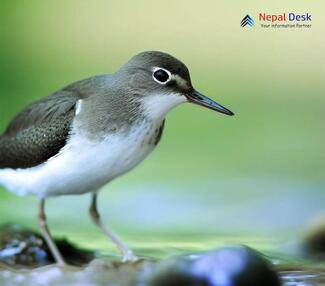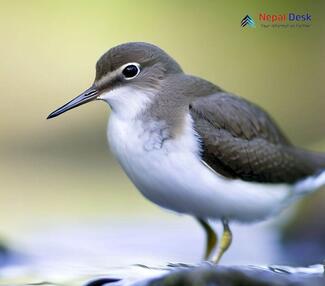Nestled in the majestic Himalayas, Nepal is a haven for birdwatchers and nature enthusiasts alike. This diverse nation is home to an impressive variety of bird species, making it a hot spot for those seeking a close encounter with our feathered friends. Among these fascinating birds is the Common Sandpiper (Actitis hypoleucos), a migratory species known for its distinct behaviors and characteristics. Swedish naturalist Carl Linnaeus was the first to formally describe the common sandpiper in 1758. Along with its American counterpart, the spotted sandpiper (A. macularia), they form the Actitis genus. These birds have distinct geographic territories and replace each other depending on the location. Let us discuss the various aspects of this Palearctic wader:
A Delightful Introduction to the Common Sandpiper
The Common Sandpiper is a small wading bird found predominantly along riverbanks, lakeshores, and wetlands throughout Nepal during migration. It is easily recognizable due to its brownish-grey plumage and white underparts, which provide perfect camouflage against rocky shorelines.
What sets this remarkable bird apart from other waders is its distinctive teetering motion. While feeding or resting on the ground, the Common Sandpiper exhibits a charming bobbing behavior that seems almost rhythmic in nature. This endearing trait has won the hearts of birdwatchers from all corners of the world.
The Journey to Nepal's Waters
As a migratory bird, the Common Sandpiper embarks on an incredible journey each year to reach its prime feeding grounds in Nepal. This voyage commences during late summer and autumn when the birds fly thousands of miles from their breeding sites in Europe and northern Asia.
Upon arrival in their temporary Nepalese home, these small wading birds navigate marshes, ponds, and river edges searching for insects and other aquatic invertebrates to feed on. Their probing beaks are expertly designed for capturing prey hidden beneath surface vegetation or buried within muddy substrates.
Nature's Marvels: The Nesting Habits of the Common Sandpiper
Following their winter sojourn in Nepal's scenic landscapes, springtime sees these agile birds returning to their nesting grounds in more temperate climates. The Common Sandpiper is known for its simplistic approach when it comes to nest construction; a mere shallow depression in the ground serves as a cozy resting place for speckled eggs.
Both male and female Common Sandpipers take on the responsibility of incubating these eggs, which typically incubate for around 21 days. Once hatched, the alert young are able to leave the nest almost immediately and embark on their own journey into wader life.
Conservation Efforts in Nepal
Nepal understands the importance of preserving its avian biodiversity. Various conservation initiatives, such as habitat protection and the designation of important bird areas, are underway to ensure that future generations also derive joy and wonder from unique species like the Common Sandpiper.
In conclusion, the Common Sandpiper is an enchanting bird species that call Nepal its winter haven. Its migration patterns, teetering motion, and nesting behavior enthrall both casual onlookers and avid birdwatchers alike. As part of Nepal's rich biological treasure trove, this delightful wader serves as a testament to the incredible natural beauty nestled within this Himalayan nation.




